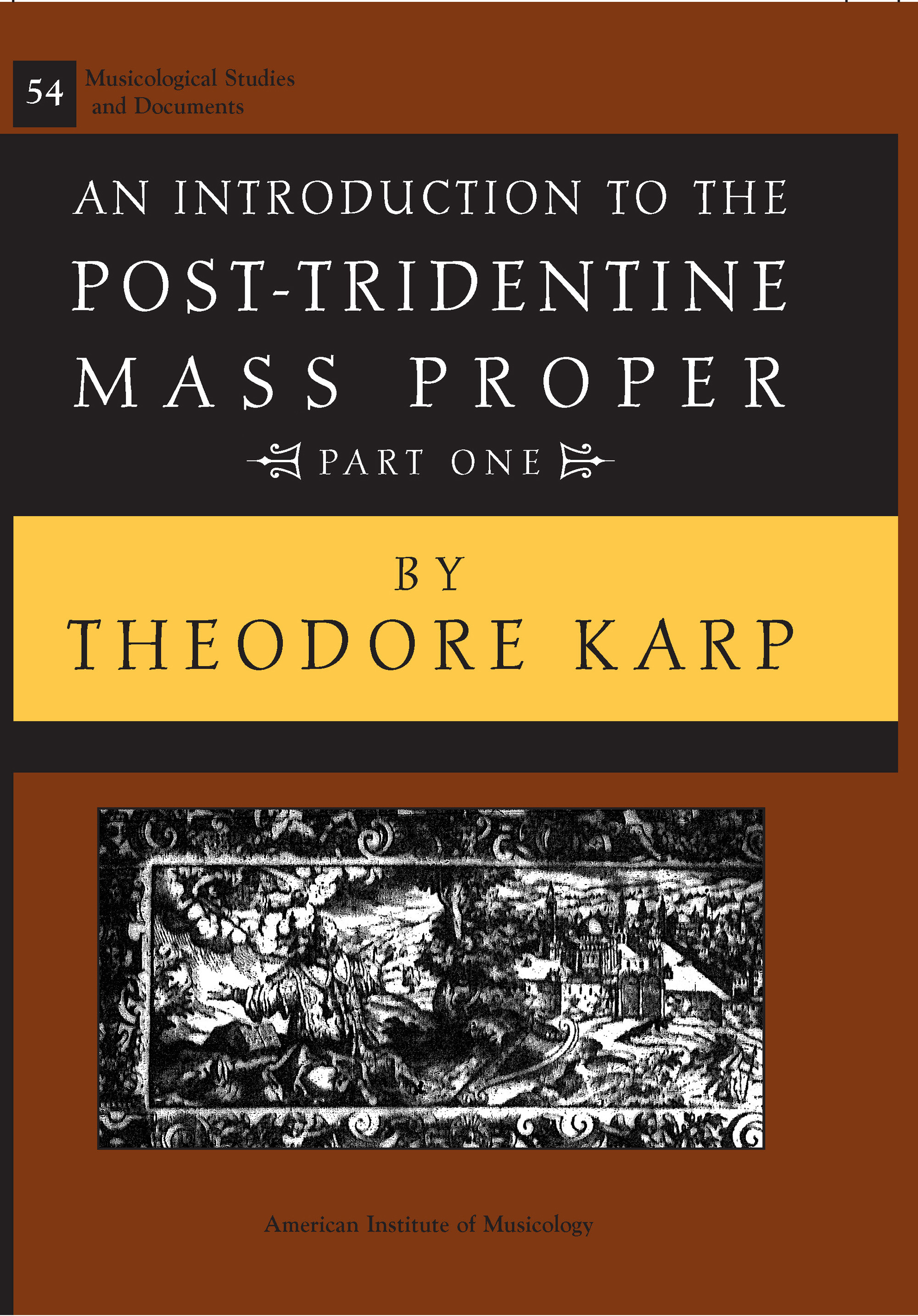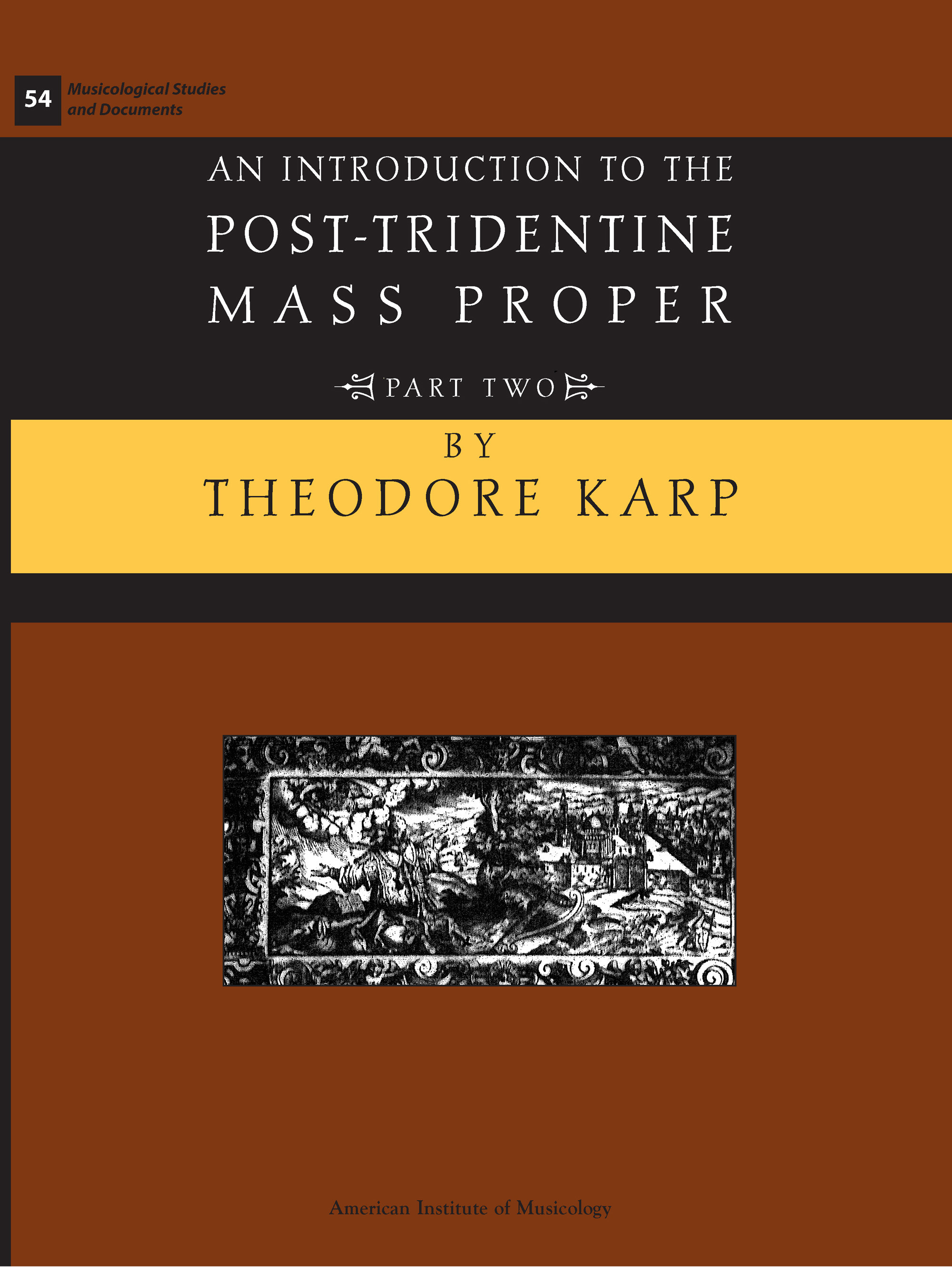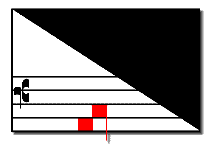New Titles
PDF Catalog
Published Series AIM
Musica Disciplina
(MD)
Corpus Mensurabilis Musicae
(CMM)
Corpus of Early Keyboard Music (CEKM)
Renaissance Manuscript Studies
(RMS)
Musicological Studies and Documents
(MSD)
Corpus scriptorum de musica
(CSM)
Miscellanea
(MISC)
Published Series IMM
Publications of Medieval Musical Manuscripts
(PMMM)
Musical Theorists in Translation
(MTT)
Collected Works
(CW)
Musicological Studies
(MS)
|
|
Theodore Karp, An Introduction to the Post-Tridentine Mass Proper
|

Contents and Sample Pages (PDF) |
MSD 54-1 Theodore Karp, An Introduction to the Post-Tridentine Mass Proper. Part 1. Text
1st. ed.
2005
36 cm
viii + 321 pp. + Audio CD
MSD 54–1
978-1-59551-339-7
$80.00
|
Abstract
The years 1590–1890 comprised a period of intensive activity in the realm of Gregorian chant, marked by two major and opposing series of fundamental changes to the repertoire. This vitality notwithstanding, only a small handful of studies provide information about chant in this period. The present monograph and edition seek to remedy this lacuna in our knowledge with respect to chants for the Mass Proper. It presents the first large-scale account of the various repertoires involved, together with transcriptions from selected primary sources. It offers also the first extensive listing of our primary printed sources. Earlier studies have indicated the most basic features of post-Tridentine revisions of chant, but these generalizations remain jejune without access to readings from major sources. These have largely been lacking. Inasmuch as no single work can offer both a panorama of the period as a whole and a detailed study of individual sources in their entireties, the author has chosen to focus in the initial and largest part of this book on five complete Mass Propers and a group of individual chants. In this fashion the reader is brought into touch with the variety of early editorial revisions of chant and also with contemporary sources that sought to adhere to previous medieval traditions.
Later chapters deal with the plainchant musical of Nivers, the virtually unknown repertories of Neo-Gallican chant, aspects of chant during the 18th century, and the major monuments of 19th-century chant that preceded the return to medieval chant sources represented by the editions issued by the Abbey of Solesmes. Issued in two physical pieces, Part 1 has text with Audio CD performances of some of the Mass Propers discussed in the book, and Part 2 has complete comparative music examples of Mass Propers discussed in the book, examples that detail variations between the various traditions transmitted in the sources.
About the Author:
Theodore Karp has contributed to our knowledge of medieval and Renaissance music in the areas of Gregorian chant, secular monophony (especially trouvère chansons), 12th-century polyphony, and polyphony of the late 15th and 16th centuries. His major works include a two-volume study of The Polyphony of St. Martial and Santiago de Compostela and a series of related essays comprising Aspects of Orality and Formularity in Gregorian Chant. He has served on the faculties of the University of California at Davis and the Northwestern University School of Music, from which he retired as Professor Emeritus in 1996.
Contents
Acknowledgments vii
1. Introduction 1
2. A Checklist of Printed Graduals ca. 1590—1890 11
3. The Third Mass of Christmas 79
4. The First Sunday of Advent 97
5. The Second Sunday of Advent 109
6. The Third Sunday after Epiphany 129
7. The Mass for Easter Sunday 149
8. A Selected Miscellany 167
9. Guillaume Gabriel Nivers and Plainchant musical 205
10. Neo-Gallican Chant 215
11. A Retrospective Glance and the Eighteenth Century 251
12. The Nineteenth Century: The Road Back 271
Notes 295
Selected Bibliography 305
Index 311
|

Contents and Sample Pages (PDF) |
MSD 54-2 Theodore Karp, An Introduction to the Post-Tridentine Mass Proper. Part 2. Music Examples
1st. ed.
2005
36 cm
x + 339 pp.
MSD 54–2
978-1-59551-345-8
$70.00
|
Abstract
Comparative chant examples.
Contents
Foreword ix
Third Mass for Christmas
1. Puer natus 3
2. Viderunt omnes [gradual: V. Notum fecit] 7
3. Viderunt omnes (Italian transmission) [gradual: V. Notum fecit] 14
4. Alleluia Dies sanctificatus 21
5. Five Members of the Dies sanctificatus family in readings of the Medicean Gradual of 1614 26
6. Five Members of the Dies sanctificatus family in readings of the Ciera Gradual of 1610 27
7. Five Members of the Dies sanctificatus family in readings of the Premonstratensian Gradual of 1680 29
8. Tui sunt coeli 31
9. Viderunt omnes [communion] 37
First Sunday of Advent
10. Ad te levavi 39
11. Universi qui te expectant [V. Vias tuas] 43
12. Alleluia Ostende nobis 49
13. Ad te Domine levavi 55
14. Dominus dabit benignitatem 60
Second Sunday of Advent
15. Populus Sion 62
16. Selected French readings of Populus Sion 66
17. Ex Sion species [V. Congregate illi] 68
18. A formulaic cluster involving Ex Sion species (Solesmes readings) 76
19. Remnants of the formulaic nexus in the Gardano Gradual of 1591 77
20. Remnants of the formulaic nexus in the Giunta Gradual of 1596 78
21. Remnants of the formulaic nexus in the Medici Gradual of 1614/15 79
22. Revised formulaic nexus in the Plantin Gradual of 1599 80
23. Revised formulaic nexus in the Laurent Gradual of 1616 81
24. Revised formulaic nexus in the Paris Gradual of 1657 82
25. Alleluia Laetatus sum 83
26. Deus tu convertens 88
27. Jerusalem surge 94
Third Sunday after Epiphany
28. Adorate Deum 96
29. Timebunt gentes [V. Quoniam aedificavit] 99
30. A family of closing melismas, including Timebunt gentes (Solesmes readings) 107
31. Similar closing melismas in readings of the Laurent Gradual of 1616 107
32. Unexpected appearances of the same cadential formula in the Laurent
Gradual of 1616 108
33. Varied statements of the same formula in the Gardano Gradual of 1591 108
34. Varied statements of the same formula in the Ciera Gradual of 1610 109
35. Varied statements of the same formula in the Medici Gradual of 1614/15 110
36. A comparison of the closing melismas for the responds of Timebunt gentes and Vindica Domine 111
37. Alleluia Dominus regnavit, exultet terra 112
38. Dextera Domini 117
39. Dextera Domini (Italian readings 122
40. Dextera Domini (French readings) 127
41. Mirabantur omnes 132
Easter Sunday
42. Resurrexi et adhuc tecum sum 134
43. Haec dies [V. Confitemini Domino] 138
44. Initial cadences for verses of the Haec dies family in the Giunta Gradual of 1596 146
45. Final cadences for verses of the Haec dies family in the Giunta Gradual of 1596 147
46. Initial cadences for verses of the Haec dies family in the Gardano Gradual of 1591 148
47. Final cadences for verses of the Haec dies family in the Gardano Gradual of 1591 149
48. Initial cadences for verses of the Haec dies family in the Medici Gradual of 1614 150
49. Final cadences for verses of the Haec dies family in the Medici Gradual of 1614 151
50. Initial cadences for verses of the Haec dies family in the Millange Gradual of 1599 152
51. Final cadences for verses of the Haec dies family in the Millange Gradual of 1599 153
52. Alleluia Pascha nostrum 154
53. Terra tremuit 159
54. Pascha nostrum 163
A Selected Miscellany
55. Domine audivi 167
56. Qui habitat 188
57. Immutemur habitu in cinere 227
58. Qui biberit 232
59. Oportet te 236
60. Deus in adjutorium 239
61. Jubilate Deo universa terra 242
62. Suscepimus Deus [V. Sicut audivimus] 249
63. Nunc dimittis 257
64. Responsum accepit Simeon 266
Nivers and plainchant musicale
65. Nivers, Graduale Romano-Monasticum Ordinis S.P.N. Francisci, 1658
a. Resurrexi et adhuc tecum sum 268
b. Haec dies [V. Confitemini Domino] 268
c. Alleluia Pascha nostrum 268
d. Victimae paschali laudes [compared with the Belgrand Gradual of 1656] 268
e. Terra tremuit 270
f. Pascha nostrum 270
66. Nivers, Graduale Romano-Monasticum Ordinis S.P.N. Francisci, 1658
a. Populus Sion 270
b. Ex Sion species [V. Congregate illi] 270
c. Alleluia Laetatus sum 271
d. Deus tu convertens 271
e. Jerusalem surge 271
Neo-Gallican Chant
67. Puer natus, Parvulus natus, and related chants 272
68. Neo-Gallican versions of the respond to Viderunt omnes 277
69. The respond of Recordatus est Dominus 279
70. Neo-Gallican versions of the Alleluia Dies sanctificatus family 281
71. The respond and first portion of the verse of Anima nostra [gradual: general transmission 286
72. French versions of Anima nostra [gradual] 291
73. Alleluia Laudate pueri 298
74. Reges Tharsis 299
75. Sicut in millibus 304
76. Proper for the Mass for the Second Sunday of Advent in the Graduale Autissiodorense 306
Chant in the Eighteenth Century
77. Four Dominican versions of Populus Sion 308
78. Four Dominican versions of Ex Sion species 309
79. Four Dominican versions of Alleluia Laetatus sum 311
80. Four Dominican versions of Deus tu convertens 312
81. Four Dominican versions of Jerusalem surge 313
The Road Back
82. Nineteenth-century readings for Populus Sion 314
83. Nineteenth-century readings for Ex Sion species 318
84. Nineteenth-century readings for the Alleluia Laetatus sum 326
85. Nineteenth-century readings for Deus tu convertens 331
86. Nineteenth-century readings for Jerusalem surge 337
|


